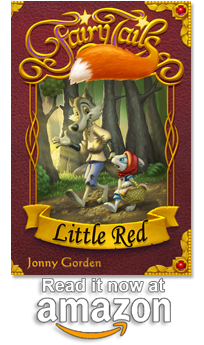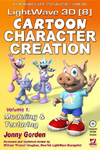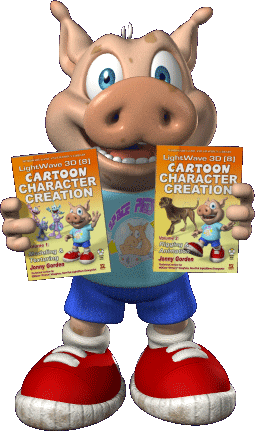 I wrote a couple of books a few years ago: Cartoon Character Creation – Volumes 1 & 2.
I wrote a couple of books a few years ago: Cartoon Character Creation – Volumes 1 & 2.
I always planned to post some excerpts here, but never got around to it. Last year, working on Chuggington with the fantastic animators at Motion Magic in China, I realized that while I have changed some of the ways I work since writing the books, the core information and methodologies remain the same, and is still very useful information that many animators aren’t aware of.
Since Chuggington is animated using Maya, and those animators were benefiting from this knowledge, it further impressed upon me how universal the information is. I was always disappointed that the books were tied to LightWave 3D 8 since so much of the information applied to 3D characters and animation in general, regardless of which software was being used. I guess this is also my chance to share that information with a wider audience.
Continuing from part 1, I’ll discuss each of the eye morphs.
Note: In LightWave, morph targets are called ‘Endomorphs’, in Maya they’re called ‘Blend Shapes’ and in Blender they’re known as ‘Shape keys’. For simplicity here I’ll just refer to them as ‘Morphs’.
Eye Morphs
The eye morphs include the motion and expression of the eyelids and eyebrows.
Before we move on to the morphs, let’s take a look at the base models for the characters used in the following examples.
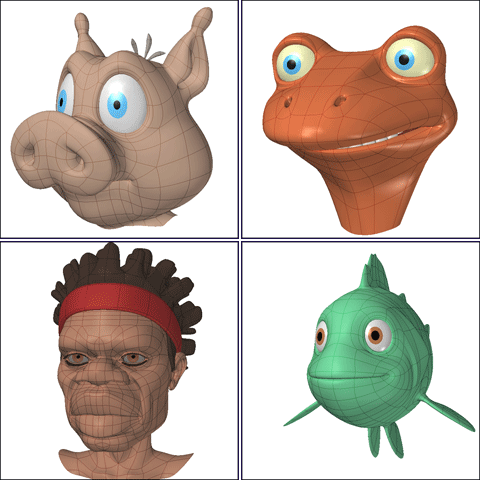
|
I’ve included a range of characters for the examples. Each character has slightly different requirements, so you can see the differences for each morph. For the eye morphs I’ve included Taylor (top-right, Taylor appears courtesy of Live Bait Productions) to show examples of the eye morphs for a character without any eyebrows.
When you’re creating your base character, try to make its expression as neutral as possible. Often the concept sketches for a character show it smiling or showing some sort of emotion. If you model emotion into the base character it makes creating and animating the facial features much more difficult, so remember to model it in a neutral expression, allowing the morphs and animation to do the job of expressing emotion.
Blink
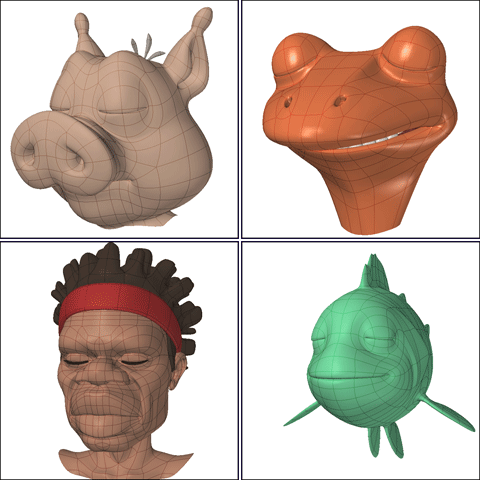
|
Blink should only affect the eyelid geometry.
When we blink, our upper lid tends to travel farther than our lower lid, creating a meeting of the eyelids about two-thirds of the way down the eye. The upper lid also tends to be slightly heavier than the lower lid, so it overlaps the lower eyelid a little bit. This also helps to define the shape of the join between lids.
This morph is used for blinking, sleeping, feeling sleepy, or anywhere else a character closes his eyes.
Squint
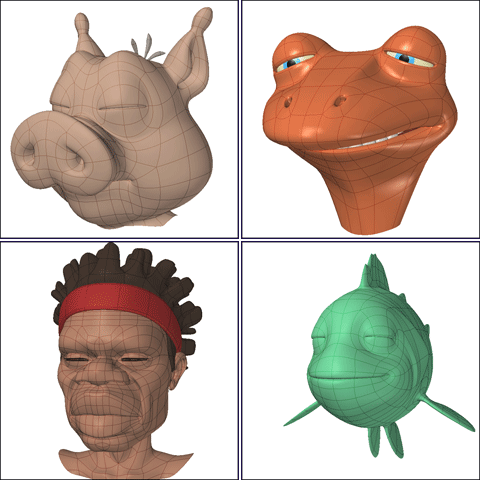
|
Squint should only affect the eyelid geometry.
The squint is very similar to the blink, except the eyelids meet in the middle of the eye.
Squint is used to convey distrust, reacting to bright light, or trying to see something far away. It can also be used for blinking when a character’s eyes are looking up.
Upper Eyelid
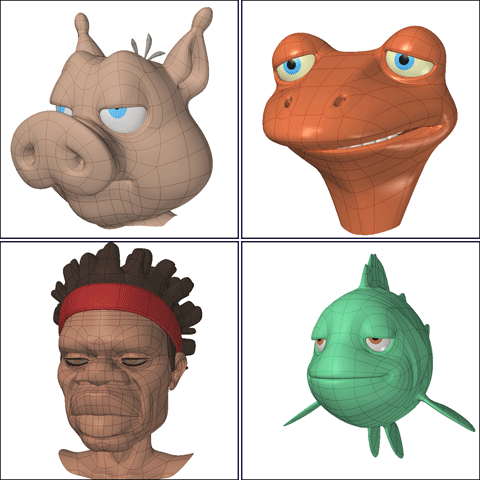
|
Upper Eyelid should only affect the upper eyelid geometry.
This is just the upper eyelid part of Squint.
The upper eyelid is used to convey condescension or can be used when a character is looking down. It can also enhance an angry expression when used with the Frown morph.
Lower Eyelid
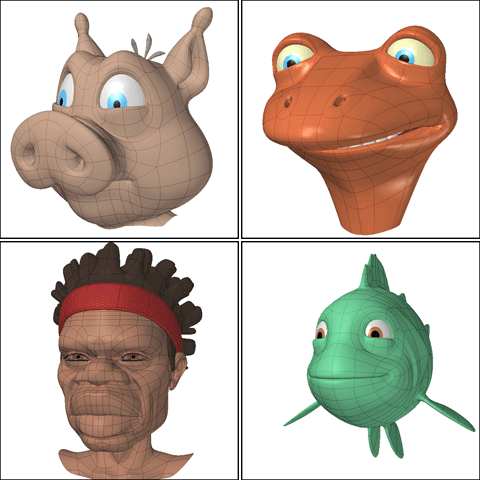
|
Lid_Low should only affect the lower eyelid geometry.
This is just the lower eyelid part of Squint.
The lower eyelid can be used to convey sadness or can be used when a character is looking up. A single lower eyelid can twitch to indicate the onset of a nervous breakdown.
Frown
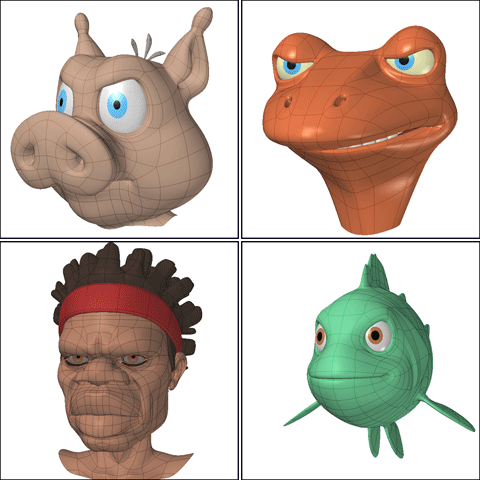
|
Frown should mainly affect the eyebrow geometry, using the top and middle areas of the eyelid to enhance the expression if necessary.
The frown is the downward movement of the eyebrows. Often some of the upper eyelid geometry is employed to some degree in cartoon characters to enhance or exaggerate the expression. For most characters, take care not to move the leading edge of the eyelid or you may need an extra morph for blinking.
The exception to this is when a character doesn’t have eyebrows (as in the top-right example); then it may be necessary to include the eyelids to produce the frown. In this case you need to reduce the Frown morph when blinking, but that’s alright because reducing the Frown morph to blink doesn’t adversely affect the expression.
The frown mainly conveys anger, although it can also convey confusion or surprise when used asymmetrically.
Sad
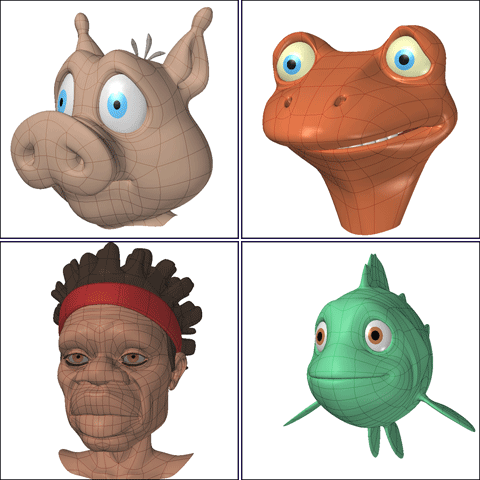
|
Sad should mainly affect the eyebrow geometry, using the top and middle areas of the eyelid to enhance the expression if necessary.
The Sad morph is the upward movement of the inside of the eyebrows. To exaggerate the expression you can also move the outside of the eyebrows down a little. As with the Frown, be careful when using the eyelid geometry to enhance the expression.
The Sad morph can convey sadness, pleading, or fear.
High

|
High should only affect the eyebrow geometry.
The High morph is the upward movement of the entire eyebrow.
The High morph can convey fear or disbelief, or confusion when used asymmetrically. It can also be used to emphasize a point.
Lift
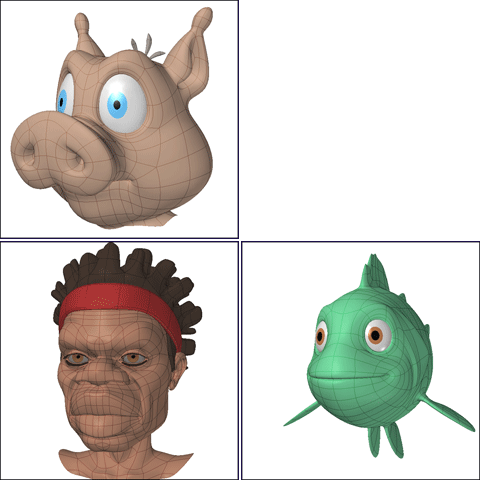
|
Lift should only affect the eyebrow geometry.
The Lift morph is the upward movement of the outside of the eyebrows.
The Lift morph can convey frustration or disbelief, or confusion when used asymmetrically.
Dilate
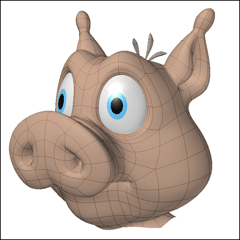 Dilate should only affect the pupil and iris of the eyeball.
Dilate should only affect the pupil and iris of the eyeball.
Dilate changes the size of the pupil. If you’ve created the pupil small, then you need to make it larger; if the pupil is large, then you should make it smaller. When the eyeball is a single sphere make sure you adjust the geometry once you’ve scaled the pupil to retain the same curvature of the eyeball as the base.
Pupil dilation is a subconscious reaction to the amount of light hitting the eyeball. The pupil becomes larger in lower light and smaller in bright light. It’s usually a good idea to default to somewhere in between the two extremes. As well as indicating the level of light, offsetting the amount of dilation for each pupil can convey insanity.
Next time we’ll take a look at the mouth morphs, the theories behind them, and how to create them. In the mean time if you’ve found this useful, or disagree with a point, or have any questions please don’t hesitate to leave a comment.


